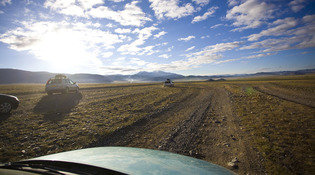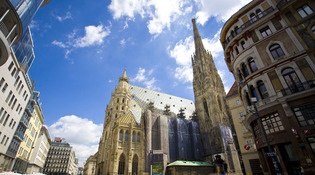 loading
loading
features5 cars. 12 Yale grads. 10,000 miles to Ulaanbaatar.After Yale, and before the rest of your life, sometimes you need an adventure. Magd Lhroob ’15 is now studying philosophy in Europe.  Mike NortonDay 36, the first full day of driving in Mongolia. Most of the driving was through remote mountain passes and bridgeless creek crossings. View full image Mike NortonThe main square in Vienna, showing St. Stephen’s Cathedral. Most of the Bad Latitudes’ time in Vienna, as in other major western cities, was spent trying to get out of the traffic in the city center. View full imageWe’ve only covered 500 miles the first time one of our cars breaks down. Just 9,500 more to go. Emergency lights flashing, our five cars pull off on a German highway, somewhere between our launch site—England—and our destination: Mongolia. The Mongol Rally is an annual road trip challenge organized by the Adventurists, a UK–based group that works to “bring chaos into over-sanitized lives.” It requires participating teams to follow only three rules:
At the start of the trip, even breaking down is novel. We’ve numbered our cars, and Car Four, the one with no AC in back, is the one with the dead engine. Our main mechanic, a DPhil student in chemical engineering at Oxford, is cursing at the car and can’t figure out what’s causing the engine to stall. Prior to the trip, most of us were strangers. I knew two of the eleven Yalies from my time there, but most are a little older, graduates of the classes of 2009, 2011, and 2013. As a 2015.5 graduate, I am the most recent alum. Only six months out of Yale, I am unsure what I’ll be doing after the rally—returning to seminary, going to graduate school, or settling into a federal consulting job. I am running out of time to deliberate and hoping for insight from my elders. But they too are at crossroads. Matt quit his first post-Yale job days before the rally. Stephen has been traveling full-time for the past year, working remotely on a number of entrepreneurial ventures. James is a former military officer in transition from active duty to law school. Maddy is one summer away from beginning Yale medical school. And Teddy, the team leader, is writing his master’s thesis in the back seat. He’s the reason we’re all here: everyone’s a friend of his or a friend of a friend. For the 2013 cohort, the rally is the ultimate reunion. For the rest of us, the new faces are part of the adventure. For all its absurdity, the Mongol Rally is not merely self-indulgent tourism. We’ve raised over $9,000 for Cool Earth and the Against Malaria Foundation. Cool Earth is the Adventurists’ official charity, and every participating team gives half its charity funds to the foundation. The Adventurists don’t find it ironic that their less-than-environmentally friendly adventures have raised over £720,000 for a charity known for protecting rainforests. They simply like the cause. Auspiciously, we’ve broken down at photography’s golden hour. We take out cameras and snap away, and in the evening light there is an almost majestic quality to our paralyzed convoy. Now that we aren’t bouncing between cell towers, data connections are also working. I take a moment to determine that Ausfahrt, a word we’d spent the afternoon discussing over walkie-talkies, is German for exit, and not the name of a city. We’re going to have to tow the car ourselves, and we are two miles from the nearest Ausfahrt, which doesn’t seem so bad given the pleasant conditions. Six hours later, we pull into a camping spot in Heidelberg, organized by the rally. Hundreds of teams have already set up tents, and we begin pitching our own on what unclaimed turf remains. I feel like I’m at the Quidditch World Cup: colorfully adorned vehicles abound, along with equally colorfully adorned rally participants (many of the teams have homemade uniforms with names and logos) who are speaking a dozen different languages. We’re fatigued but take a moment to gather near the huge communal campfire. Matt is the self-appointed morale builder. He begins recapping our trip so far, giving honorable mentions to members who did something worthwhile. Most of us he calls “dead weight,” and we laugh despite our exhaustion. Then we clap a cacophonous drum roll for him so he can announce the Rallier of the Day. It’s Mark—the only Russian speaker on the trip. The mechanics who stopped when they saw our stalled car had turned out to be Russians, and had Mark not communicated with them, we would have been stranded till the morning. Rallier named, Matt calls for an all-hands huddle. We count one, two, three—and scream “Bad Latitudes!” Then we scatter to get as much sleep as possible before we have to drive again.
|
|